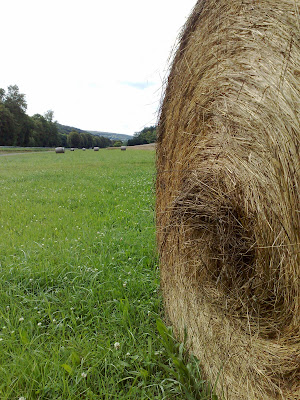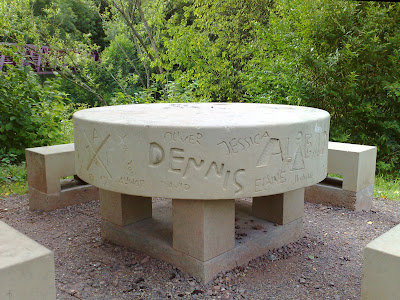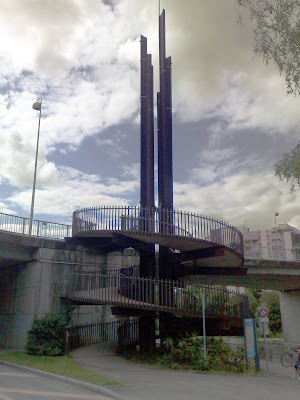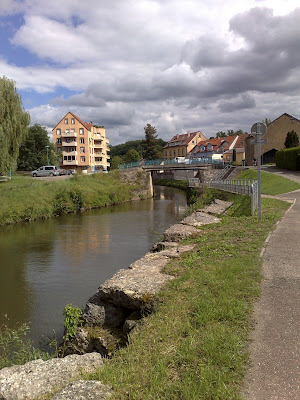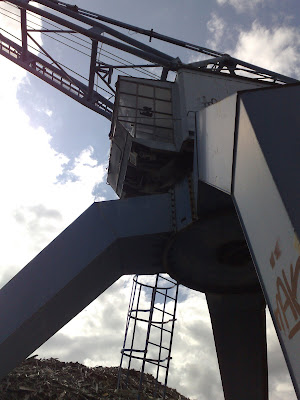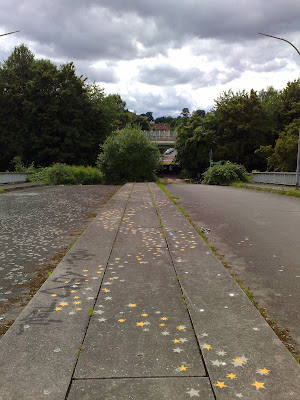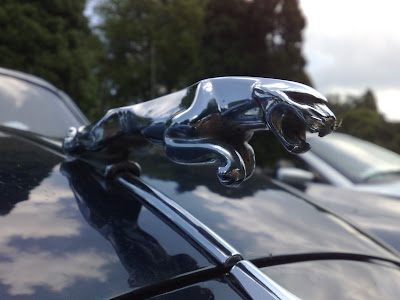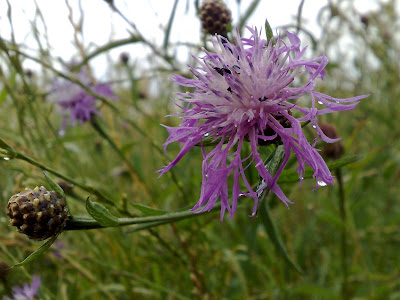2009-07-31
Open-air theatre in the valley of the Countess
A few metres away from the Gräfinthal monastery, isolated in glorious countryside, there is an open-air theatre. Although it is far from any town, although the performances can be cancelled by rain, although the actors are amateurs from nearby villages, the theatre still manages to attract over 20,000 visitors every summer. This season they are performning Shakespeare's As you like it and Guareschi's Don Camillo and children's favourite Urmel on the ice. Book your tickets online, and pray it does not rain.
2009-07-30
Pigeon loft on stilts
This pigeon abode is located in Gräfinthal Monastery, founded in 1245 by Countess Elisabeth of Blieskastel. Legend has it that she founded the monastery after being cured of an eye disease by the miraculous powers of the "Our Lady with the Arrows" icon. It became a popular place of pilgrimage. After its heyday in the 18th century, it fell into ruins, but it has now been renovated, and since 1993, it has been home to monks from the Dutch Abbey of Vaals. So, it seems the monastery is back in business. I am not sure about the dovecote, though.
2009-07-29
Recycled cycle
There must have been a shortage of plant pot holders in France, but the resourceful inhabitants of the village of Blies-Guersviller found a way to put their colourful blooms on display.
2009-07-28
Rustic Lorraine
The pleasant valley of the River Blies, where it forms the border between Germany and France. This is the southern, French side.
I am sure hay bails used to be box shaped. I wonder what further advances in hay technology await us in the 21st century.
2009-07-27
Encouraging the inevitable
A table in an unattended area outdoors. The kids are going to write their names on it anyway. Why not let them write their names on it from the start?
2009-07-26
Jardin publique
To be found at the end of the bridge. I thought the blue glass squares were novel, an instance of French flair.
2009-07-25
Asymmetric suspension
An elegant suspension bridge where the load carrying single pole is not in the middle, but to one side, giving the bridge a nice sweeping look. This bridge takes pedestrians to one of Sarreguemines pleasant park areas.
Sarreguemines (Saargmünd in German) is 18km from Saarbrücken, but the towns are connected by a modern tram, the Saarbahn. Often, when I try to talk to the people in French, they will notice I am not from there and answer, frustratingly for me, in fluent German.
2009-07-24
Spiral ramp à la française
This is Sarreguemines' analogue to Saarbrücken's graffiti spiral — a pedestrian way down to the riverbank from a bridge across the Saar. I will leave it to blog readers to draw their own conclusions on how these reflect national or municipal character. The Sarreguemines version is crowned by an EU flag that is just out of shot and the bridge is the Pont de l'Europe.
2009-07-23
Micro Venice on the Saar
This shot was taken much in the spirit of 2009-06-23, that is to say on a cycle path near the Franco-German border, where the border itself is not marked. It is only when the path crosses some houses that you have some indication which country you are in. These are some of the first houses directly on the path after leaving Saarbrücken. The brownish tones the houses are painted in are not so popular in Saarbrücken and this is, indeed, Sarreguemines in France. Would you have guessed it was France?
2009-07-22
Old blue crane
A crane whose legs straddle the towpath along the Saar. It obviously was able to unload boats. It looks like it has seen better days and I am not sure if it still works. Nearby there is plaque that explains that there used to be a power station here that was used during the 1950s. There is also a picture of the day in the 1990s when they detonated explosives and reduced the massive power station to rubble. I would have loved to have taken a photograph of that.
2009-07-21
Graffiti tower
This tower is to be found on the towpath along the Saar. It seemed so typical of Saarbrücken — a colourful, dilapidated building in the middle of idyllic green. I have no idea what it was used for. It is actually located near yesterday's bridge. Perhaps, it is the tower to nowhere.
2009-07-20
Starry road to nowhere
We kept reading during Sarah Palin's time on the campaign trail that the Alaskans wanted to build a bridge to nowhere. Well, they need not have bothered. Saarland already has nowhere fully connected. In the picture, you see a supremely sturdy, well-tarmacked bridge, leading from nowhere on one side to nowhere on the other. It must have seemed like a good idea at the time.
2009-07-19
Platz des unsichtbaren Mahnmals - The Square of the Invisible Memorial
Above you can see the Saarbrücker Schloss (Palace). It has been the site of some castle or palace since mediaeval times. Its present contours were given to it by the famous baroque architect Friedrich Joachim Stengel in the 18th century, although it has suffered several bombings, fires and rebuildings since then. What you cannot see above is the aptly named invisible memorial. In 1993, the art professor Jochen Gerz and his students chiselled the names of 2,146 Jewish cemeteries on cobblestones and placed the stones in the square with the name-side down.
If you are thinking of visiting the palace, I would suggest you do it on a Sunday morning. Then a friendly ghost will give you a guided tour.
2009-07-18
Shade
I have taken several shots of trees that have been polled. There seem to be several reasons for cutting trees like this: to increase the longevity of the tree, aesthetics and to increase its leafy shade. This last point is demonstrated in the photo. The tree stands above some benches in the main high street in Saabrücken, offering respite from the sun to weary shoppers. Its form is obviusly the product of human pruning
2009-07-17
The return of the baroque
This is the silhouette of the Schlosskirche, once a Protestant church, now a museum. It is what a citizen of Saarbrücken would have seen from the time of the church's construction in 1743 until it was bombed in 1944. As the church was rebuilt from ruins after the war, no money was available for such a splendid tower and it was topped with a simple pyramid form. Only in 1999 did the city manage to restore the tower to its former baroque glory.
2009-07-16
Glistening tentacles
These long, thin, vertical metal tentacles are opposite the fat, reclining metal tentacles. I am not sure if they are related or if they have any alien connections.
2009-07-15
Shades of green with white speckles
One of the myriad of flowers that line the footpaths in the woods these days.
Having failed to identify the common cornflower, I subsequently invested in a nature guide and can tell you with absolute certainty that the species pictured above is Maianthemum bifolium or some white flower or other. Maianthemum bifolium is called disparagingly False lily of the valley in English, or more appropriately Schattenblume (shade flower) in German.
2009-07-14
Slaughterhouse Brasserie
There are not many redbrick houses in Saarbrücken. So, this restaurant reminds me a bit of England. Except, however, that the English seem to have vegetarian tendencies and they would not usually name a restaurant so bluntly as "Slaughterhouse", nor have models of the animals on display whose flesh you are about to consume.
2009-07-13
Quality seduces
Advertising for a fruit and vegetable wholesaler. By the way, you may have to click for the larger version of the photo to see the apple the woman is offering.
2009-07-12
Shunned French belle
There were about 30 British roadsters glistening in the sun, but one car was parked far away from the others in the shade. Despite her beautiful, elegant curves, she had not been invited to the party: she had not been made in the land of the Union Jack.
2009-07-11
Wild cat leaping
As I was walking in the park area along the bank of the Saar, I encountered a row of classic cars parked on the grass. On closer inspection, I noticed lots of Union Jacks decorating the vehicles: all were classic British roadsters, Jaguars, MGs and their ilk. I just had to take a photo of this little emblem from my homeland.
2009-07-10
Mithras' grotto
The reason, of course, that there are chained stone fungi in the middle of the woods is that they decorate the path in front of a Mithraic temple.
The explanatory plaque beside the above scene reads:
Mithrashöhle - Heidenkapelle
In dieser Höhle wurde in römischer Zeit der Kult des persischen Lichtergottes Mithras zelebriert.
Im Mittelalter diente sie als Wallfahrtsklause. Hier soll Bischof Arnualdus das Christentum gepredigt haben.
Unterhalb des Gewölbes bedfindet sich eine Inschrift. Sie stammt aus dem 19. Jahrhundert, als die Familie Stumm den Halberg bewohnte. Der Text spricht von heidnischen Priestern und dem legendären Missionar Arnualdus.
Mithras' Cave- Pagen ChapelThe chained fungi were presumably put there by the Stumm family.
In this cave in Roman times, the cult of Mithras, the persian god of light, was celebrated.
In the middle ages it served as a hermitage and place of pilgrimage. Bishop Arnualdus is supposed to have preached here.
Underneath the vault there is an inscription. This is from the 19th century when the Stumm family lived on the Halberg hill. The text mentions the pagan priests and the legendary missionary Arnualdus.
2009-07-09
Chained fungi
Where are these stone fungi? What are they doing in the middle of the woods? At least some of the mystery will be revealed tomorrow.
2009-07-08
Große Gaia - Big Gaia
This is the work of Brigitte and Martin Matschinsky-Denninghoff before the city art gallery (Moderne Galerie des Saarlandmuseums).
2009-07-07
Summer in the city
All cities organise events in the summer and Saarbrücken is no slouch here. Every weekend, some part of the city will be having its Fest. Last weekend was the turn of the Altstadt, the old, renovated, street-café area. It has the usual mix of music, handicraft stalls, beer and sausages.
2009-07-06
Altstadt Fest
The spirit of Jimi Hendrix lives on! Guitar burning seems to back in fashion. Guitar makers around the world will be celebrating extra sales.
2009-07-05
Funnel of neglect
This reminds me of the beacon of neglect. It must have been built at around the same time. It is in slightly better shape, but it looks like originally water flowed through the channel in the middle. However, the only water I have ever seen there is rain water.
2009-07-04
The cult café?
Two weeks ago, Saarbrücken was upgraded to McCafé status in the burger empire. Say what you will about McDonalds, but I had always wished someone would build a café in the location —Römerkastell, now a major public transport interchange — and their coffee and toasted bagel did not taste so bad.
2009-07-03
Tank in the rain
After over four decades of German occupation, Spicheren returned to France in 1919. However even before the start of Word War II, the Germans were back, building military fortifications on French soil as part of the Siegfried Line. During the war it remained in German hands until liberated by the Americans in 1945. In 1995, an American infantry regiment gave the village this tank.
The village and its military relics are now used by the French and German authorities as a means to remember the past while celebrating the current lack of frontiers. Around 30% of the inhabitants of Spicheren are German citizens and since 2005, teaching in the primary school has been bilingual.
2009-07-02
Remembering the fallen
Spicheren is not only known for its corn. On August 6, 1870, the Battle of Spicheren took place here, a decisive moment in the Franco-Prussian War. On that day, on the grass just below this scene of this photo, over 1,000 men lost their lives and around 5,000 were wounded. When the Germans later occupied Lorraine, they erected several monuments on the site of the battle, including this one from the 39th Infantry Regiment. As the village web site points out, they must have employed a French stone mason: he made several spelling errors such as Officiere instead of Offiziere.
2009-07-01
Flower in the rain
A rather damp flower in a cornfield in French Spicheren, a few metres away from the German border. Coincidentally, the name of the village comes from the Latin spicarium, granary.
Subscribe to:
Posts (Atom)



